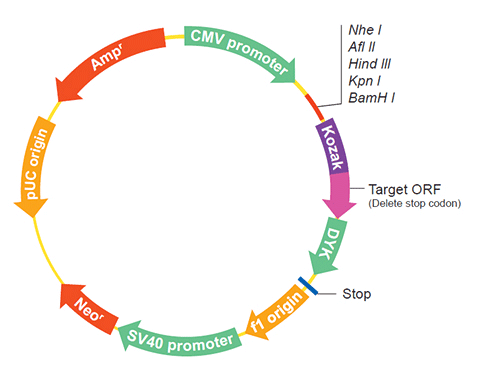| Gene Symbol | RLN2 |
| Entrez Gene ID | 403742 |
| Full Name | relaxin 2 |
| Synonyms | RLN,RLN1,relaxin |
| Gene Type | protein-coding |
| Organism | Canis lupus familiaris(Dog) |
HOME
ORF » Species Summary » Canis lupus familiaris » RLN2 cDNA ORF clone
| Gene Symbol | RLN2 |
| Entrez Gene ID | 403742 |
| Full Name | relaxin 2 |
| Synonyms | RLN,RLN1,relaxin |
| Gene Type | protein-coding |
| Organism | Canis lupus familiaris(Dog) |
| mRNA | Protein | Name |
|---|---|---|
| NM_001003132.1 | NP_001003132.1 | prorelaxin precursor |
| XM_014113974.1 | XP_013969449.1 | prorelaxin isoform X1 |


Testicular steroids, prolactin, relaxin and prostate gland markers in peripheral blood and seminal plasma of normal dogs and dogs with prostatic hyperplasia.
Wolf K, Kayacelebi H, Urhausen C, Piechotta M, Mischke R, Kramer S, Einspanier A, Oei CH, G?nzel-Apel A
Reproduction in domestic animals = Zuchthygiene47 Suppl 6243-6(2012 Dec)
Investigation of the local expression of the relaxin system in canine mammary tumours.
Lamp O, Honscha KU, Jakob J, Lamp J, Schweizer S, Reischauer A, Gottschalk J, Hahn A, Ebert M, Rothemund S, Blaschzik S, Einspanier A
Reproduction in domestic animals = Zuchthygiene44 Suppl 2224-9(2009 Jul)
Canine preprorelaxin: nucleic acid sequence and localization within the canine placenta.
Klonisch T, Hombach-Klonisch S, Froehlich C, Kauffold J, Steger K, Steinetz BG, Fischer B
Biology of reproduction60(3)551-7(1999 Mar)
Purification and sequence determination of canine relaxin.
Stewart DR, Henzel WJ, Vandlen R
Journal of protein chemistry11(3)247-53(1992 Jun)
GeneRIFs: Gene References Into Functions What's a GeneRIF?
The blood levels of multiple steroids and other hormones in adult male dogs with or without prostatic hyperplasia are reported.
Title: Testicular steroids, prolactin, relaxin and prostate gland markers in peripheral blood and seminal plasma of normal dogs and dogs with prostatic hyperplasia.
The expression of relaxin and its receptors in canine mammary neoplasm tissue were studied, indicating a possible significant role of relaxin as an inducer of connective tissue remodelling.
Title: Investigation of the local expression of the relaxin system in canine mammary tumours.
The following RLN2 gene cDNA ORF clone sequences were retrieved from the NCBI Reference Sequence Database (RefSeq). These sequences represent the protein coding region of the RLN2 cDNA ORF which is encoded by the open reading frame (ORF) sequence. ORF sequences can be delivered in our standard vector, pcDNA3.1+/C-(K)DYK or the vector of your choice as an expression/transfection-ready ORF clone. Not the clone you want? Click here to find your clone.
| CloneID | OCe33845 | |
| Clone ID Related Accession (Same CDS sequence) | NM_001003132.1 | |
| Accession Version | NM_001003132.1 Latest version! | Documents for ORF clone product in default vector |
| Sequence Information | ORF Nucleotide Sequence (Length: 534bp) Protein sequence SNP |
|
| Vector | pcDNA3.1-C-(k)DYK or customized vector |  User Manual User Manual |
| Clone information | Clone Map |  MSDS MSDS |
| Tag on pcDNA3.1+/C-(K)DYK | C terminal DYKDDDDK tags | |
| ORF Insert Method | CloneEZ™ Seamless cloning technology | |
| Insert Structure | linear | |
| Update Date | 2019-09-20 | |
| Organism | Canis lupus familiaris(dog) | |
| Product | prorelaxin precursor | |
| Comment | Comment: PROVISIONAL REFSEQ: This record has not yet been subject to final NCBI review. The reference sequence was derived from AF233687.1. ##Evidence-Data-START## Transcript exon combination :: AF233687.1 [ECO:0000332] RNAseq introns :: single sample supports all introns SAMEA103936001, SAMEA103936002 [ECO:0000348] ##Evidence-Data-END## | |
1 | ATGCTGCGCT GGTTCTTGTC CCACCTGCTA GGTGTCTGGC TGCTACTAAG CCAACTTCCC |
The stop codons will be deleted if pcDNA3.1+/C-(K)DYK vector is selected.
| RefSeq | NP_001003132.1 |
| CDS | 1..534 |
| Translation |

Target ORF information:
Target ORF information:
|
 NM_001003132.1 NM_001003132.1 |

1 | ATGCTGCGCT GGTTCTTGTC CCACCTGCTA GGTGTCTGGC TGCTACTAAG CCAACTTCCC |
The stop codons will be deleted if pcDNA3.1+/C-(K)DYK vector is selected.
| CloneID | OCe34544 | |
| Clone ID Related Accession (Same CDS sequence) | XM_014113974.1 | |
| Accession Version | XM_014113974.1 Latest version! | Documents for ORF clone product in default vector |
| Sequence Information | ORF Nucleotide Sequence (Length: 534bp) Protein sequence SNP |
|
| Vector | pcDNA3.1-C-(k)DYK or customized vector |  User Manual User Manual |
| Clone information | Clone Map |  MSDS MSDS |
| Tag on pcDNA3.1+/C-(K)DYK | C terminal DYKDDDDK tags | |
| ORF Insert Method | CloneEZ™ Seamless cloning technology | |
| Insert Structure | linear | |
| Update Date | 2015-09-16 | |
| Organism | Canis lupus familiaris(Dog) | |
| Product | prorelaxin isoform X1 | |
| Comment | MODEL REFSEQ: This record is predicted by automated computational analysis. This record is derived from a genomic sequence (NW_003726047.1) annotated using gene prediction method: Gnomon, supported by mRNA evidence. Also see: Documentation of NCBI's Annotation Process ##Genome-Annotation-Data-START## Annotation Provider :: NCBI Annotation Status :: Full annotation Annotation Version :: Canis lupus familiaris Annotation Release 104 Annotation Pipeline :: NCBI eukaryotic genome annotation pipeline Annotation Software Version :: 6.4 Annotation Method :: Best-placed RefSeq; Gnomon Features Annotated :: Gene; mRNA; CDS; ncRNA ##Genome-Annotation-Data-END## | |
1 | ATGCTGCGCT GGTTCTTGTC CCACCTGCTA GGTGTCTGGC TGCTACTAAG CCAACTTCCC |
The stop codons will be deleted if pcDNA3.1+/C-(K)DYK vector is selected.
| RefSeq | XP_013969449.1 |
| CDS | 87..620 |
| Translation |

Target ORF information:
Target ORF information:
|
 XM_014113974.1 XM_014113974.1 |

1 | ATGCTGCGCT GGTTCTTGTC CCACCTGCTA GGTGTCTGGC TGCTACTAAG CCAACTTCCC |
The stop codons will be deleted if pcDNA3.1+/C-(K)DYK vector is selected.
Testicular steroids, prolactin, relaxin and prostate gland markers in peripheral blood and seminal plasma of normal dogs and dogs with prostatic hyperplasia. |
Investigation of the local expression of the relaxin system in canine mammary tumours. |
Canine preprorelaxin: nucleic acid sequence and localization within the canine placenta. |
Purification and sequence determination of canine relaxin. |